Mark Sisson's Blog, page 294
July 8, 2014
7 Powerful Ways to Make Walking More Exciting
 This is guest post from Kevin Geary. Kevin is the founder of Rebooted Body, host of The Rebooted Body Podcast, and creator of the Total Body Reboot online program. He uses a unique blend of ancestral science and modern psychology to help men and women reprogram their body and mind for sustainable fat loss, vibrant health, and peak performance. Enter Kevin…
This is guest post from Kevin Geary. Kevin is the founder of Rebooted Body, host of The Rebooted Body Podcast, and creator of the Total Body Reboot online program. He uses a unique blend of ancestral science and modern psychology to help men and women reprogram their body and mind for sustainable fat loss, vibrant health, and peak performance. Enter Kevin…
Walking is the number one underrated activity for health and fat loss. But, it’s time consuming and it often lacks excitement, which are the main objections I hear. Until now.
Look, I’ve made these same objections myself. Some days I love walking and some days I can think of better things to do. Sometimes I have a lot of time and sometimes I’m pressed for time.
But it’s something that has to be done. You’re a human being. You have to move. Sitting is killing you and going to the gym a few times a week isn’t going to change that.
What I’ve done is come up with some techniques for spicing up the activity of walking, which will help you want to fit it in. I also give some tips for fitting walking into your busy schedule.
This isn’t a list of shallow suggestions like, “listen to podcasts” or “take your dog.” It’s a list of ways to be more engaged and excited about the activity itself and to create a deeper connection with your primal nature.
1. Breath Walking
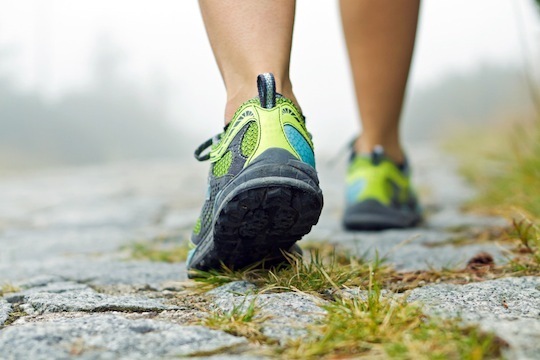
This is a mental exercise as much as it’s a physical one. It also happens to be the number one way to ensure you’re completely present on your walks.
It’s simple: breathe only through your nose for the entire walk. Don’t open your mouth. If you need to slow down at any point, do so, but keep breathing through your nose.
If you hate meditating or think meditating is woo-woo stuff, then just do this exercise on your walks and you’ll get many of the same benefits.
I wouldn’t recommend that you do this on ALL your walks, but it’s a great exercise to employ from time to time.
2. Exploration Walking

If you walk the same path every day, it’s no wonder you’re bored. If you walk on concrete every time, same thing.
When you walk the same path day in and day out, your mind wanders. You’re just going through the motions. It’s a small fraction of what it could be.
Walking used to be about traveling. You’d walk to new places, see new things, and explore. Often, you’d be scavenging for food or water.
Adopt that mindset! Reconnect with your primal nature. Don’t set out with a distance or a plan. Don’t set out to follow a “course.”
Start on your normal path and then take a random detour. Be willing to get lost. Be willing to get wet. Be willing to walk through fields and forests.
When you’re exploring, all five senses are honed in on the land in front of you. Cherish that, it doesn’t happen often these days.
When I walk with my daughter, I notice she stops often and engages with stuff. She’ll pick stuff up, look at it, smell it. She’s two — and 200% present. Reconnect with that part of your humanity. Be okay with slowing down, stopping, and taking the time.
Bonus points if you can forage for wild foods. It’s not easy. Research online for how to identify them, collect them, and prepare them.
3. Agility Walking
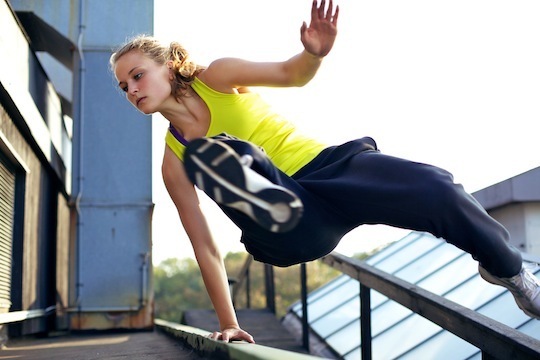
You’re going to need to channel your inner child for this one.
I’m not a fan of running — the monotonous, pounding activity that so many people love to destroy their bodies with. But, that’s not to say that you can’t run, ever.
Agility walking is the most dynamic form of walking that I’ve come up with. It’s a mix of walking, strategic running, leaping, climbing, and sometimes crawling. It also perfectly compliments exploration.
Here’s how it works: If the landscape is flat or downhill, then walk. If it grades uphill, then jog. Mix in the exploratory nature (veer off course) and start tackling obstacles. Don’t walk around the downed tree, leap over it. Fence in the way? Don’t find your way around, climb it.
You can do this in a forest or an urban jungle. My last agility walk took me through a park where I hit the monkey bars, slid down a slide, climbed the fence to the baseball field, sprinted across the field, climbed the other fence, and then went back to walking.
There’s no recipe. It’s all about making the trip as dynamic as possible and incorporating as many movements as you can into the activity.
You can do this whether you’re 20 or 80, just tailor it to your individual abilities. Yes, it still counts as walking because you end up walking for a majority of the time. But it’s a hell of a lot more fun.
4. Travel Walking
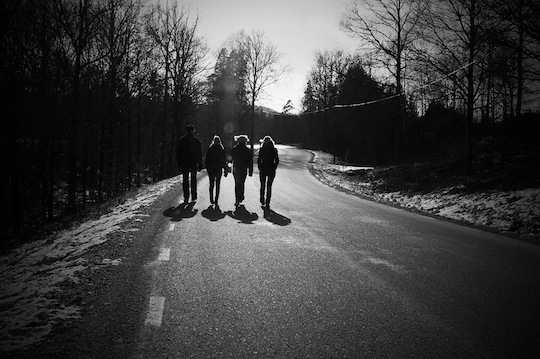
Oh my God, I’ve got this great idea!
What? What is it?
We could actually walk to our destination!
I was in Austin, Texas for the PaleoFX conference recently and an odd question kept coming up. When we were heading out for lunch or to after-conference meet-ups, the question was, “should we drive or walk?”
You wouldn’t think that conversation would come up at a Paleo conference, but alas, it happened often.
Sad, I know.
So, I chimed in as quickly as possible: walk!
Homo Sapien Domestico Fragilus — as my friend Daniel Vitalis refers to our modern subspecies — is always so quick to make things more convenient and less physically demanding. How often have you had the same conversation?
If your destination is within 5 miles and you’re not pressed for time, then walk! Cherish the fact that you don’t have to walk in a circle today just to escape the doom of your convenient lifestyle. You have somewhere to go — that’s exciting!
My footprints are ALL OVER Austin. And I’m better off for it. And I got to see more of the city than I would have if we had taken a car everywhere.
5. Vary the Time of Day & Conditions

Want a quick way to know if you belong to the fragile, domesticated version of Homo Sapien that I mentioned earlier?
Think about the time of day you tend to walk. In the Summer, early morning or early evening when the sun is low in the sky to “beat the heat?” In the Winter, mid-day when it’s warmest? Always when it’s bright, because the darkness is dangerous? Always when it’s dry, because you might melt if it’s raining?
You’re infected with the domestication virus. Sorry.
The good news is that it’s curable. Varying the time of day you walk and the conditions you walk in are the antidotes to your fragility.
Walk when it’s cold. Walk when it’s hot. Walk when it’s dark. Walk when the sun is rising or setting. Walk when it’s raining.
Experience the variability. Life shouldn’t always be a steady 70 degrees. Live a little.
6. Walk Barefoot
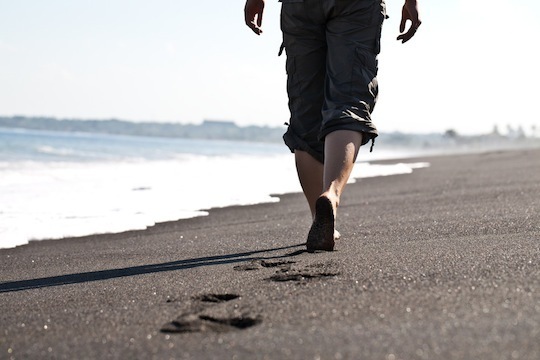
If you’re walking in barefoot shoes or minimalist shoes, you’re doing pretty well. But I want to challenge you to take it a step further.
It doesn’t matter if you’re walking on concrete or planning on heading off the beaten path, barefoot is the way to go. Even if you only go full barefoot once in a while, it’s a step up in your walking game.
There’s nothing like feeling the Earth — putting the nerves in the bottom of your feet against the soil is as primal as it gets.
Sure, it’s more dangerous. You could get cuts and scrapes. But it’s worth it. The more you do it the tougher your feet will get and the more intuitive you’ll be (to avoid dangerous things).
It’s also a great way to ground yourself. While there may be controversy in the science surrounding the benefits of grounding, there’s no doubt that barefoot is the natural state of walking.
7. Walking Workout
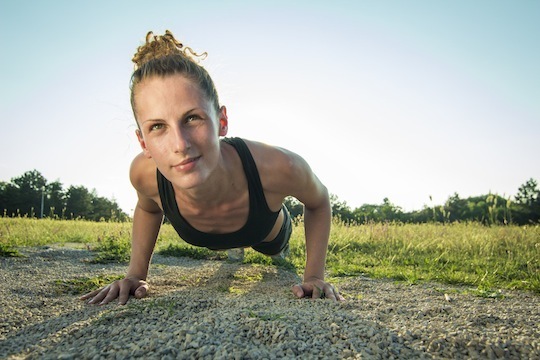
One of the biggest objections I get from clients is, “I can do the bodyweight strength training, resistance training, and sprint sessions — those are short and sweet. But walking on top of all that is just too much of a time investment.”
I so get it! We’re all busy. I quit my job to build Rebooted Body full time and I’ve never worked more in my life. So, what’s my solution?
Step One: Make daily activity a priority — schedule the time.
Step Two: Walking Workouts to combine walking with a workout to fit it all in.
A Walking Workout is where you combine bodyweight strength training or a sprint session with your walk. You can spread it throughout the entire walk, pausing at various points, or you can do the workout portion all at once in the middle or at the end of the walk.
If you’re clever, you can do this with resistance training too. It depends on how Grok you wanna be with finding big logs, rocks, and so on.
A big benefit to this is that the brisk walking is a great warmup for whatever else you’re going to do. And it’s a natural cool down as well. Perfect.
A final tip for staying motivated.
As humans, we need to be walking — intentionally — every day. Understanding this, let me help you deal with all the excuses and objections with one single tip.
Here it is…
It doesn’t matter if you have five minutes or 5 hours, get outside and walk intentionally every single day.
There’s plenty of days where I feel too busy or unmotivated. On those days, I just walk to the end of my street and back. Five to ten minutes. When I’m feeling motivated, I’ll walk for an hour or two.
Avoid boxing yourself into plans and schedules. Saying, “I’ll walk 30 minutes a day” is too rigid. Habits come from doing things without fail, but building a habit has nothing to do with duration of the activity.
What you’ll find when you walk daily without setting time limits is freedom. Most of the time, once you’re out the door you’ll decide to go further than you felt like going. But, if you think you MUST do some arbitrary amount of time, you may not make it out the door at all.
If you have any tips for making walks more exciting or engaging, I’d love to hear them in the comments section!
Join Mark Sisson and Friends in Sunny Southern California this Sept. 25-28! Get Your Tickets for PrimalCon Oxnard 2014 Today and Finally Meet Your Tribe!




July 7, 2014
Dear Mark: 1000 Calories a Day, No Appetite After Exercise, and How to Not Lose Weight
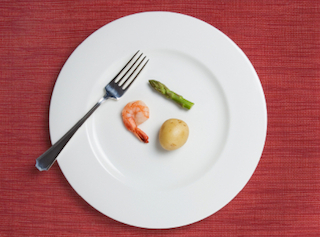 For today’s Dear Mark, I’m taking three questions. First, I comment on Mick Dodge’s (the barefoot forest-living guy with the beard on the NatGeo show) claim that humans can thrive on 1000 calories a day. Is it true? Next, I discuss whether or not people need to worry about a distinct lack of appetite following exercise. Should they listen to their bodies or force down some food? And finally, how should a person who doesn’t want to lose weight go about a Primal way of eating?
For today’s Dear Mark, I’m taking three questions. First, I comment on Mick Dodge’s (the barefoot forest-living guy with the beard on the NatGeo show) claim that humans can thrive on 1000 calories a day. Is it true? Next, I discuss whether or not people need to worry about a distinct lack of appetite following exercise. Should they listen to their bodies or force down some food? And finally, how should a person who doesn’t want to lose weight go about a Primal way of eating?
Let’s go:
Dear Mark,
A few months ago, I saw a show on National Geographic about Mick Dodge, a guy who lives as a hunter gatherer in a rainforest in Washington state. He mentioned that the human body actually needs very little food, and he’s conditioned his body to live off 1000 calories a day. Is he right? Is this because of his primal [blueprint] diet? Or is he just crazy?
Thanks,
Isaac
There’s a difference between surviving and thriving.
I’m dubious about his claim. Is he weighing and measuring his grubs, cattails, and pine bark? Does he keep a FitDay account? Promo videos show him running barefoot through the forest, which looks like a great way to spend an afternoon but also increases his caloric expenditure and thus requirements. Plus, it’s a reality TV show. Those are notorious for stretching the truth and using selective editing to further a narrative.
Now, I’m not knocking Mick Dodge. I haven’t watched the show (just a few clips and I’ve read a couple things), but I dig his overall ethos and I suspect he’s just speaking about his own experience. I like his promotion of barefoot living – not just running. And what he says about the bare foot offering an entirely new sensory perspective on one’s surroundings is spot on. Even though we often focus on the utilitarian aspects of going barefoot – the altered loading of the lower limbs, the increased efficiency, the potential to reduce injury – the broadened sensory awareness is a huge benefit that doesn’t get enough credit. Plus, his apprentice that sometimes appears on the show – Will of Stone – came to PrimalCon Oxnard last year. Great guy, great kilt.
Let’s assume his claims are accurate, and he manages to maintain a decent physique, enough energy to run around the rainforests of the Pacific Northwest, and a modicum of sanity on a daily diet of 1000 calories. Good for him, but he’s an outlier. The vast majority of published research shows that people just don’t function very well on 1000 calories a day.
Heck, the most famous caloric restriction study of all, the Minnesota Starvation Experiment, used diets of 1560 calories a day to induce starvation symptoms in adult males who had previously been eating 3200 calories a day. And they weren’t running barefoot, foraging for food, climbing trees, or lifting logs and heavy rocks while on it. They merely maintained their regular walking habit of 22 miles a week. The symptoms were severe:
They became depressed, hysterical hypochondriacs. Most of them experienced bouts of severe emotional distress, and there was even an instance of self-mutilation (a guy cut off three fingers with an axe). Interest in sex vanished (and erections grew scarce), replaced by interest in food. Metabolic rate plummeted across the board, as did body temperature.
So yes, we can technically survive on 1000 calories a day, but it isn’t going to be pretty. And doing so while living off the land would be nearly impossible for most people.
Of course, the rules change when you have hundreds of thousands of calories attached to your body and available for utilization. The severely obese can get away with ultra-low calorie intakes because they’re consuming all the calories stored in their adipose tissue. This is why an obese 27 year-old Scotsman was able to fast for 382 consecutive days, consuming nothing but water, vitamin supplements, and his own body fat. He reached his goal weight and, as of the paper’s publishing date, was able to maintain it in good health on a normal diet.
Hi Mark,
Sorry to trouble you but I’m a bit confused. I’m trying to follow my body’s signals for hunger but I’m almost never really hungry after my workout for at least a couple of hours. I know you recommend occasional post-workout fasting. My goal being fat loss, is a protein-rich PW meal crucial? Should I eat something anyway?
Thanks for taking out the time to answer this.
Nish
As long as this “not being hungry” business only happens after you work out and you’re eating a sufficient amount of food overall, go with it. The body can probably be trusted if all your ducks are in a row and you have a healthy relationship with food. And if fat loss is your primary concern, you’re on the right track. Both intense exercise and fasting increase growth hormone, and growth hormone promotes fat burning. Just don’t take things to an extreme and suppress the urge to eat (eat when hunger ensues naturally - WHEN) and things will take care of themselves.
Protein eaten immediately post-workout can help muscle recovery and promote hypertrophy, but even the importance of the post-workout “anabolic window” is exaggerated. Unless you’re looking to wring every last drop of muscle-building potential out of your body, you’ll do just fine eating protein a couple hours after.
I’m a lot like you, actually. I generally don’t get very hungry after a workout. If I’m not hungry, I don’t eat, and it’s worked out well. Others may have the opposite response to training. Efficient fat-burners tend not to be ravenous after exercising because they’ve burned more fat and spared more glucose during the workout and don’t need the immediate glycogen replenishment from dietary carbohydrates.
People just respond differently to training. There’s no one “right” way.
Dear Mark,
I am a fifty year-old woman with a long standing history of gastric disturbances which have previously been put down to irritable bowel, and now peri-menopausal hormone fluctuations plus h-pylori – both of which are causing distressing acid reflux and nausea.
I am certain that the answer lies in my diet, which has always been carb heavy – particularly as I am a “pesca/vegetarian”.
My problem is that I am very small (5ft tall, and currently just 40kg) and I lose weight at the drop of a hat. I recently started a low FODMAP diet accompanied by some tips from your web site regarding grains, but I lost 4kg (from 44 to 40) in just over a week.
Can I follow a low carb paleo style diet without losing weight? I’m scared to keep going.
Thank you for any assistance or direction you may have.
Kind wishes,
Erica
Many people can maintain their weight while eating relatively low-carb. I can. It may just be that you can’t go low-carb and maintain your weight. That’s fine, and it doesn’t mean you can’t be Primal. Although I’m a proponent of only eating and burning as much glucose as you have to in a lifetime, I don’t think carbs are evil. I’m relatively agnostic on that front. I even support up to 150 grams of carbs from starches and fruits (not even counting non-starchy green vegetable carbs) on the Primal Blueprint carb curve for weight maintenance for most people (athletes will often go even higher). I just want people to know what they’re doing and why they’re doing it. My motto with carbs is basically “eat them as you need them.” For most people, that means tailoring their carbohydrate intake to their activity levels: when they train hard and long, they eat a few more carbs. For you, that may mean using your weight to determine the amount of carbs you need: when you start losing weight, you eat a few more carbs.
Besides, just because you’re on a low-FODMAP diet doesn’t mean you must eliminate carbs. Most tubers are low-FODMAP, except for something like sweet potato. Regular potatoes, bananas, white/wild rice, even some fruits are all acceptable. Review the list of foods to avoid on a low-FODMAP diet; anything else is fair game.
You’ll also have to eat enough food. I mean, that seems like it should go without saying, but you’d be surprised. Low-carb tends to reduce appetite because the foods are so nutrient dense, and because protein and fat are so filling. It’s easy to forget to eat when you’re not very hungry. Great for losing weight, not when you need to gain it. So:
Drizzle a little extra olive oil on your salad. No, a little more than that. There you go. Just like that.
Throw a little more potato on your plate and melt another pat of butter on it. Go on, do it. Don’t be shy.
Flip that roast chicken carcass over. You’re not done with it. See those little tender morsels of chicken flesh there nestled on either side of the spine? Those are the oysters (not oysters, although those are good, too). Dig your index finger in and pop ‘em out. See that crispy little triangle down near the bottom? That’s the Pope’s nose, the perfect union of cartilage, fat and meat; rip it off and eat it. And you were about to throw the carcass out.
Keep snacks on hand. Dark chocolate, nuts, jerky, bananas. If you slice and dry the bananas, you can combine all four to make the greatest trail mix in the history of human history.
That’s it for today, everyone. Be sure to leave a comment for me or, if you have some additional advice, for anyone who asked a question this week. I know they appreciate your insights. I sure do.
Join Mark Sisson and Friends in Sunny Southern California this Sept. 25-28! Get Your Tickets for PrimalCon Oxnard 2014 Today and Finally Meet Your Tribe!




July 6, 2014
Weekend Link Love
 Episode #26 of The Primal Blueprint Podcast is now live, and we’re talking to Dr. Cate Shanahan. As a practicing family physician who moonlights as a metabolic consultant to elite athletes like Kobe Bryant and the LA Lakers, Dr. Shanahan has extensive experience working with people from all walks of life with every manner of metabolic dysfunction. She’s seen it all, and now she’s ready to see you – remotely. To learn more about what she’s offering with the new metabolic consulting service, The Primal Advantage, give it a listen. If you have any ideas or questions for future podcasts, please let us know by using the blue “Submit a Question” button in the sidebar!
Episode #26 of The Primal Blueprint Podcast is now live, and we’re talking to Dr. Cate Shanahan. As a practicing family physician who moonlights as a metabolic consultant to elite athletes like Kobe Bryant and the LA Lakers, Dr. Shanahan has extensive experience working with people from all walks of life with every manner of metabolic dysfunction. She’s seen it all, and now she’s ready to see you – remotely. To learn more about what she’s offering with the new metabolic consulting service, The Primal Advantage, give it a listen. If you have any ideas or questions for future podcasts, please let us know by using the blue “Submit a Question” button in the sidebar!
Research of the Week
Tibetans picked up the ability to efficiently use oxygen at high altitudes by reproducing with a now-extinct line of ancient humans, the Denisovans.
In a new lifelong feeding study, water fleas (a model organism for toxicological research) fed a diet made up of Roundup-ready soybeans had the lowest growth and fertility rates and died soonest. Those on an organic soy diet fared the best.
Interesting Blog Posts
Don’t toss those strawberry tops.
GMO soybean oil bad (for DNA and inflammatory markers), extra virgin olive oil good: Dr. Andro digs into the latest study to confirm what we pretty much already know.
Media, Schmedia
Man, going paleo really hasn’t done much for Tim Howard’s reflexes, agility, reaction time, and overall athleticism.
Oh, wait.
The BBC takes a hard look or two at England’s sugar consumption.
Everything Else
How one Canadian veteran is treating his PTSD with standup paddle boarding. I definitely approve.
Who doesn’t love Thai food? Unfortunately, it can be tough to let loose and enjoy yourself at a Thai restaurant when half the time you’re craning your neck to see what kind of oil they’re using in the kitchen and wondering if those rice noodles are really just rice. With Sarah Fragoso’s new Everyday Paleo: Thai Cuisine, you can make the food yourself using quality ingredients. No more guesswork, just eating.
Pretty soon, anyone with a smartphone will be able to track their stress levels with a quick, easy, inexpensive cortisol testing app. I can see this doing more harm than good for some folks.
If people were more tolerant of ugly-looking produce, we’d waste far less food.
Scientists ran genetic tests on all the samples of “yeti fur” they’d received from around the world and found nothing out of the ordinary. It was all just a bunch of regular animal fur. I’m disappointed, but the abominable snowman lives on, if only in my dreams.
Most people prefer electric shocks to confronting the contents of their own minds.
Recipe Corner
Let’s admit it: fish and chips are really, really good. These bacon breaded fish nuggets with homemade tartar sauce really hit the spot.
Since we’ve now all got Thai food on the brain, try making this grilled sirloin salad with fresh herbs and Thai dressing.
Time Capsule
One year ago (July 6 – July 12)
An Open Letter to Doctors – Wherein I attempt to help medical professionals understand where we’re coming from – and where they might consider going.
12 Easy Ways to Primalize Your Everyday Life – A dozen fun, helpful, simple suggestions for making life more rewarding, healthy, and Primal.
Comment of the Week
Walter Willett can kiss my entire basckside! I’ve got a stack of mammograms that say he’s DEAD WRONG about red meat and breast cancer.
Not a Subscriber? You Are Missing Out. Subscribe for Free Today and Instantly Get 8 Primal eBooks and So Much More!




July 5, 2014
Flank Steak and Mango Slaw with Scallion Garlic Oil
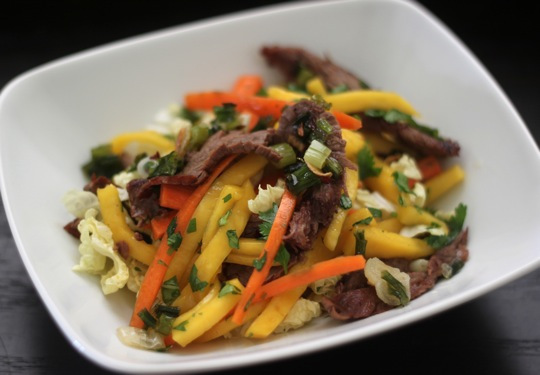
Sweet and spicy. Filling and refreshing. Veggies and meat. This flank steak and mango slaw with scallion oil has it all. While there’s a lot to like about grilled flank steak tossed with crispy cabbage, sweet mango and fresh herbs, it’s the scallion garlic oil that turned out to be the real star of the meal. It gives meat and veggies a spicy kick and addictive garlic flavor you won’t soon forget. It’s a condiment you can pour over all sorts of different salads, as well as seafood, pork and chicken.
Mango adds a sweet flavor to this slaw that nicely complements the spicy dressing and grilled steak, and in this small quantity is worthy of being a sensible vice but… mango is optional if you’re avoiding fruit with a higher glycemic index. A red bell pepper can add color and a little sweetness instead, if you prefer.
Servings: 4
Time in the Kitchen: 1 hour
Ingredients:

Salad:
1 pound flank steak (450 g)
1/3 cup coconut aminos or tamari (80 ml)
2 tablespoons sunflower, olive or coconut oil (30 ml)
1/4 cup fresh lime juice (60 ml)
4 garlic cloves, finely chopped
1 mango, peeled and sliced into thin strips
2 carrots, grated or very thinly sliced
1 small head Napa cabbage, thinly sliced/shredded
1/3 cup finely chopped fresh basil (80 ml)
1/2 cup finely chopped fresh cilantro (120 ml)
Scallion Garlic Oil:
3 scallions, thinly sliced
2 garlic cloves, thinly sliced
1/2 cup cold pressed high-oleic/high-stearic sunflower oil (120 ml)
1 tablespoon red pepper flakes (15 ml)
1 teaspoon toasted sesame oil
Instructions:
Marinate steak at room temperature for 30 minutes in the coconut aminos, oil, lime juice, and garlic cloves.
While steak marinates, make the scallion oil. Put the scallions, 2 garlic cloves, sunflower oil and red pepper flakes in a small saucepan over medium heat. Cook, swirling around the oil in pan occasionally, 3 to 5 minutes until the garlic is lightly browned. Take off the heat, add the sesame oil, and let cool.
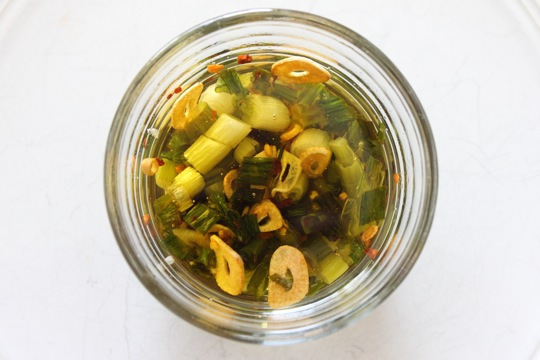
Heat grill to medium-high heat. Grill the steak for about 6 minutes a side. Depending on the thickness of the steak, it might need additional cooking time with the heat on the grill turned down to medium (or if using a charcoal grill, move the meat away from the hottest part of the grill). Let the steak rest for 5 to 10 minutes before thinly slicing.
In a large bowl combine the mango, carrot, cabbage, basil and cilantro.
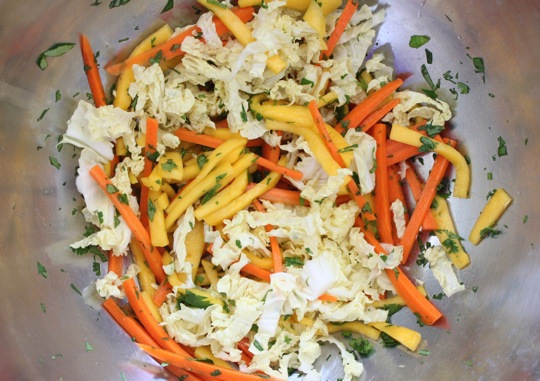
Add the strips of steak to the salad bowl. Drizzle in the scallion garlic oil and toss well.
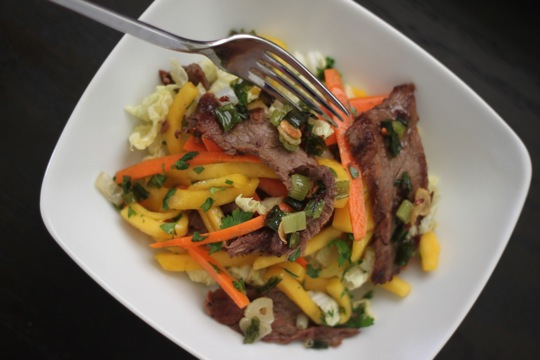
Not Sure What to Eat? Get the Primal Blueprint Meal Plan for Shopping Lists and Recipes Delivered Directly to Your Inbox Each Week




July 4, 2014
Boy Meets Sisson, Overcomes “Reverse Dysmorphia”
It’s Friday, everyone! And that means another Primal Blueprint Real Life Story from a Mark’s Daily Apple reader. If you have your own success story and would like to share it with me and the Mark’s Daily Apple community please contact me here. I’ll continue to publish these each Friday as long as they keep coming in. Thank you for reading!
 Hello… my name is Matt and I am a recovering “reverse dysmorphic,” and I have been in recovery since 2011. “Body Dysmorphia” is basically defined as the inability to see a realistic body image of one-self. Some dysmorphics see themselves as fat, no matter how thin they get. I do not have this problem; I have “reverse dysmorphia,” in that no matter how large I get, I always think I look goooood.
Hello… my name is Matt and I am a recovering “reverse dysmorphic,” and I have been in recovery since 2011. “Body Dysmorphia” is basically defined as the inability to see a realistic body image of one-self. Some dysmorphics see themselves as fat, no matter how thin they get. I do not have this problem; I have “reverse dysmorphia,” in that no matter how large I get, I always think I look goooood.
Examples:
At 5’10” and 220 pounds, I was in the obese range on the BMI… my reaction: “Can you believe that?! Me? Obese? Come on, the BMI doesn’t take into account just how large my bones are. Seriously, I ride my bike all the time… I eat a low fat diet… I’m sexy.”
I used to say to my wife… “We’re not fat! We’re just a bit chubby… and there’s a BIG difference.”
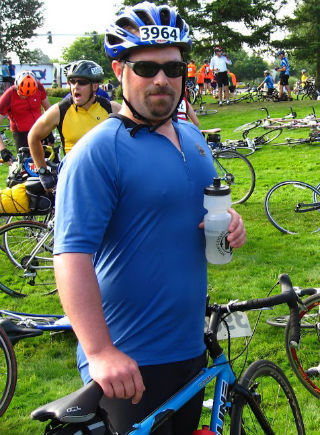 In this picture, I’m on a 200-mile bike ride called Seattle to Portland (STP), and when I saw this picture I thought, “Bad angle. Those darn bike shirts are always too small and tight; must be for the aerodynamics. Only Lance looks good in those shirts, and look at what he had to do to get there. Seriously, I’m on a 200-mile bike ride for cryin-out-loud, I really can’t be that chubby. Darn bike shirts!”
In this picture, I’m on a 200-mile bike ride called Seattle to Portland (STP), and when I saw this picture I thought, “Bad angle. Those darn bike shirts are always too small and tight; must be for the aerodynamics. Only Lance looks good in those shirts, and look at what he had to do to get there. Seriously, I’m on a 200-mile bike ride for cryin-out-loud, I really can’t be that chubby. Darn bike shirts!”
In the next picture I’m trying to jump high and get my picture taken at the apex of the jump. My wife took at least 25 pictures of me attempting this “jump,” and I was so frustrated at her inability to snap a picture at the right time: “I mean come on! I’m obviously on the way down here… I’m obviously jumping more than 2” off the ground. Darn digital cameras!”
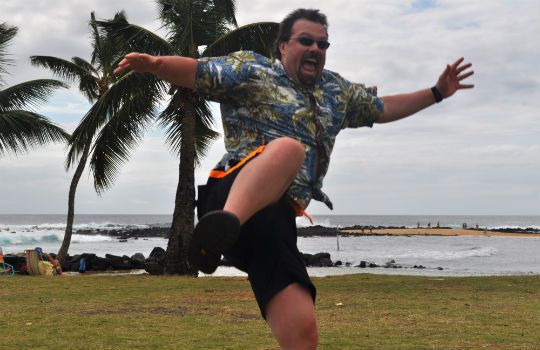
I lived this way for years. In the late 90s I hit 220 and stayed there for over 10 years. I rock climbed, rode long distance roads and mountain bike rides, trained for, and ran, 2 marathons, and for a while, got addicted to spinning. And in all that time, and all that exercise, my body weight never budged and my reverse body dysmorphia just got more entrenched. It seemed that the more active I got, the better I thought I looked.
However, there were times I’d “wake-up” and really see my body, and I would try one of the diets-of-the moment. At one point (pun intended) I tried Weight Watchers and managed to lose nine pounds. In the insanity of that diet, I saved enough “points” to eat 40 (yes, I would count them) Goldfish crackers. Looking back at that now I’m amazed that in conventional wisdom, eating processed food is totally okay, as long as you stay within your daily calorie count… regardless of how bad the food is for you health-wise. Obviously none of those diets worked, and as soon as I stopped the diet, I gained back all the weight I lost… and then some more.
In 2009, my wife and I moved to Anchorage, Alaska, where for some unknown reason, we thought it would be a good idea to do pizza and beer every Friday night. Over the course of a year my weight started creeping up higher and higher and my response was: “Hell, we live in Alaska, the extra weight is helping me stay warm… it’s gotta be my body’s response to this cold weather.”
Then in 2011, thankfully my dysmorphic bubble popped with this picture:
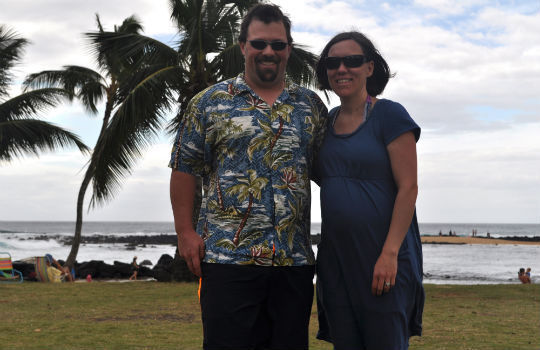
(My wife wants you to know that she is pregnant in this photo… I am not.) I looked at this photo and thought… “Holy cow (not the word I used), I’m HUGE!”
At that moment, when all my dysmorphic fantasies evaporated into thin air and I saw how huge I’d gotten, I thought, “Time for Weight Watchers.”
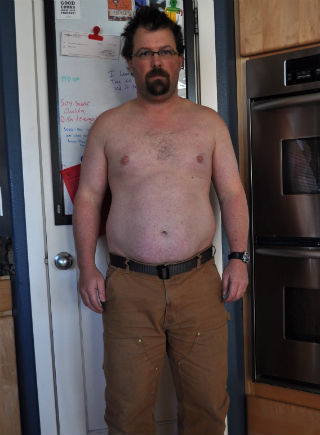 Thankfully, at that time I had a buddy who told me about this guy, Mark Sisson, who did this Primal eating thing, and since he’d already lost about 10 pounds, I thought I’d give it a try. Here’s how I looked the day after my buddy told me about The Primal Blueprint.
Thankfully, at that time I had a buddy who told me about this guy, Mark Sisson, who did this Primal eating thing, and since he’d already lost about 10 pounds, I thought I’d give it a try. Here’s how I looked the day after my buddy told me about The Primal Blueprint.
From here it’s the usual story:
Boy meets Sisson.
Boy reads The Primal Blueprint (the chapter about the Korgs and the Groks completely changes his view on food and exercise).
Boy stops eating all processed food, grains, gluten and buys a grass-fed bison.
Boy buys Five Finger “shoes” (confirming wife’s believe that he is, in fact, a dork).
Lifts heavy things.
Walks slow over long distances.
Sprints every now and then.
… and in five months looks like this.
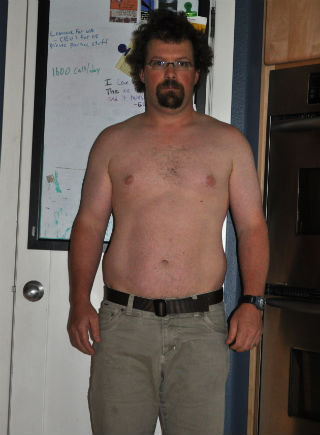 In this photo I’ve dropped 10 pounds and I’m feeling very good. Here are the health changes I experienced by losing those 10 pounds by getting rid of processed food and grains.
In this photo I’ve dropped 10 pounds and I’m feeling very good. Here are the health changes I experienced by losing those 10 pounds by getting rid of processed food and grains.
GERD – I’d lived with GERD for years and was taking anti-acids every night. In the time it took me to lose this weight, my GERD was gone, and has never come back.
Nighttime anxiety – Ever since I can remember I would wake up in the middle of the night with a rather intense anxiety feeling. I just assumed it was some sort of normal reaction to the night, but within these five months my mid-night anxiety vanished, and has never come back. Lack of grains?
Late afternoon lethargy – gone.
Gas – other than my buddy Darren, I had the WORST gas ever, and since that time I am amazed, and those around me are VERY happy, to report that I rarely, if ever have gas.
Energy – I’ve always been known as an “energetic” person, however I have even more energy than before. I have young 2 children and feel like I can keep up with them quite easily.
Cholesterol – I got my cholesterol checked in 2012 and 2013 and my numbers got better between the two years.
My wife and I have fully changed over to the Primal way of eating. My wife, a doctor, has done a ton of reading about Primal eating, and is a true believer who shares her new knowledge with her patients. She herself has a few amazing stories of patients losing weight and curing themselves of chronic ailments due to switching over to Primal-like diets.
In 2013, still at 216, my wife suggested we do The Whole30, and in about 25 days, by getting rid of ALL sugar (which I learned is in almost everything), legumes, dairy, and alcohol. I got to 207 pounds.
Also, in 2013 my wife introduced me to Bikram Yoga, which has become the 3rd rail of my healthy way of life. Sorry Mark… but I just couldn’t keep up with going to the gym and lifting and sprinting… and going to Bikram yoga two times a week has been fantastic for me!
Every Friday I read another “success story,” and wondered when I’d feel it was okay to share my story… I thought, “I am a reverse-dysmorphic, so how would I know it was the right time to share my story?” Well my answer came the other day when I went clothing shopping. I pulled pants off the rack, size 36”, which I’d worn for YEARS. But when I went to try them on, I was swimming in them. I tried on 34” pants, a size I hadn’t worn in over 20 years, and they fit… loosely. If they had 33”, I would have gone with those. I figured in that moment, “Numbers don’t lie…” and decided I’d like to share my story with Mark.
 Here’s a recent photo. I sure don’t have a beach body, however, at 43, because of Primal eating, I’ve managed to not only lose 20 pounds, but thankfully have managed to maintain that weight for over three years. And most importantly, I feel healthy! In conclusion, I would like to share the most significant lessons I’ve learned over the past three years, which are:
Here’s a recent photo. I sure don’t have a beach body, however, at 43, because of Primal eating, I’ve managed to not only lose 20 pounds, but thankfully have managed to maintain that weight for over three years. And most importantly, I feel healthy! In conclusion, I would like to share the most significant lessons I’ve learned over the past three years, which are:
This is not a diet. Primal eating is a lifestyle. I always failed at diets because when I went back to a conventional diet, I just gained the weight back.
Changing one’s lifestyle takes a long time. I always tell people who are just starting that this should be a marathon, not a sprint… but make sure to sprint every now and then.
Don’t start with Whole30… way too restrictive if one is starting from a conventional diet. Doing Whole30 after living Primal for three years was a very easy transition and had huge benefits for me.
I cannot do 80/20… I just spent way too much time in the 20%. In order to be successful, I have to be at a 95/5, and when I do eat outside the Primal diet I try, as best as possible, to make it a high quality cheat.
Alcohol is a gateway to crappy eating… I avoid beer as much as possible, which is insanely hard during the summer months.
Trying to work out harder the day after a major over-indulgence does not work… it just makes me want to eat more crappy food.
This is a MUCH EASIER process if those you live with are also on the same path.
I want to thank Mark and all those out there in the blogosphere who have helped me both get on, and stay on, this Primal path. Grok On!
Matt
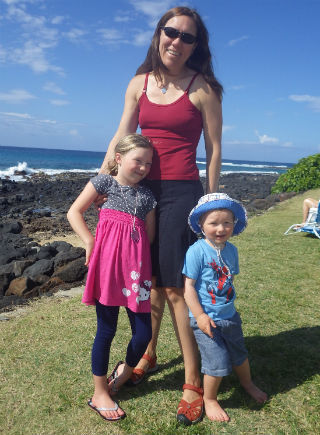 P.S. – And proof that this lifestyle has also worked for my wife, here’s a picture of my hot, Primal eating, Bikram yogi wife and our babies.
P.S. – And proof that this lifestyle has also worked for my wife, here’s a picture of my hot, Primal eating, Bikram yogi wife and our babies.
P.P.S. – Obviously I subscribe to the theory that, “If you can’t laugh at yourself, who can you laugh at?” Everything I’ve written above is painfully true about my “reverse dysmorphia,” and hopefully it is obvious that I have made up the concept of RD to make fun of myself. However, at the same time “Body Dysmorphia” is a real issue and one that negatively affects many people. It is not my intention to make light of dysmorphia and I hope I do not offend. If I do, I apologize and hope people can see that I am making fun of myself… and myself only. ☺
Not a Subscriber? You Are Missing Out. Subscribe for Free Today and Instantly Get 8 Primal eBooks and So Much More!




July 3, 2014
An Ounce of Prevention Is Worth…?
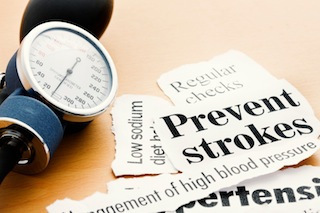 It’s official: 1 out of every 2 Americans has a chronic health condition. Additionally, twenty-five percent have more than one chronic condition. In a new series initiated by the Centers for Disease Control (the first paper recently published in The Lancet), researchers note that chronic diseases have, in fact, overtaken the human health scene, with noncommunicable conditions causing two-thirds of global deaths. In the U.S., we likewise see the impact in terms of mortality but also in terms of personal disability as well as health care expenditures. Previous reports from the CDC claim a staggering 84% of health care costs go toward treatment of chronic conditions. Is there a way off of this sick merry-go-round? How about the old adage about prevention being worth a pound of cure? For all its seeming practicality, is the prevention mindset – and protocol – the best answer, let alone the panacea?
It’s official: 1 out of every 2 Americans has a chronic health condition. Additionally, twenty-five percent have more than one chronic condition. In a new series initiated by the Centers for Disease Control (the first paper recently published in The Lancet), researchers note that chronic diseases have, in fact, overtaken the human health scene, with noncommunicable conditions causing two-thirds of global deaths. In the U.S., we likewise see the impact in terms of mortality but also in terms of personal disability as well as health care expenditures. Previous reports from the CDC claim a staggering 84% of health care costs go toward treatment of chronic conditions. Is there a way off of this sick merry-go-round? How about the old adage about prevention being worth a pound of cure? For all its seeming practicality, is the prevention mindset – and protocol – the best answer, let alone the panacea?
The State of Affairs
Authors of the CDC series share the “short list of risk factors” associated with the individual incidence (and societal prevalence) of these chronic conditions as “tobacco use, poor diet and physical activity…excessive alcohol consumption, uncontrolled high blood pressure, and hyperlipidaemia [high cholesterol].” While I have my own diverging and nuanced takes on the cholesterol issue in particular and would likely add chronic stress, I can’t argue much with the list itself. We suffer as the result of the most basic choices and deficits. It makes the premise of preventative medicine seems so elementary, but clearly we’re (collectively speaking anyhow) missing the boat. What does preventative medicine end up encompassing in the conventional scheme of things?
The CDC report authors cite, for instance, their organization’s four-pronged approach to prevention strategy: “(1) epidemiology and surveillance to monitor trends and inform programmes; (2) environmental approaches that promote health and support healthy behaviours; (3) health system interventions to improve the effective use of clinical and other preventive services; and (4) community resources linked to clinical services that sustain improved management of chronic conditions.”
While one hope of prevention strategy holds that additional contact with health providers can allow for essential nutrition and fitness counseling, surveys of actual doctors complicate this picture. Research shows that less than a quarter of doctors feel confident or particularly qualified offering diet and exercise advice to their patients. Surveys, in fact, have demonstrated that medical students continually receive inadequate nutrition training with a mere 22.3 hours of instruction on average. The results show. Less than one-eighth of physician visits include fitness or nutritional counseling. Given the prevalence of obesity and chronic illness, clearly one-eighth isn’t going to cut it.
Beyond the public health monitoring and the clinical intervention practices are the “self-management education” and the “supportive community environments.” (I think Primal folks have some experience with these concepts….) It’s another complex tier of incorporating and maintaining healthy behaviors that are the linchpin for prevention but may be at odds with conventional lifestyle practices, particularly in certain regions or population communities. Public health campaigns go out of their way to make healthy choices appear “normal,” but the reality can feel very different. It’s no surprise that people tell me time and again how embracing the Primal Blueprint as a counter-cultural lifestyle helped them adhere to the PB and actually enhance their investment in it.
The Paradigm of Prevention
The core issue of – or perhaps beyond – prevention is investment, I believe. Education – actually physiologically sound education – is key. People have to know the correct information to make positive change. (This is still a problem in CW society, but progress is being made here and there.) Nonetheless, after education (or with it), it’s about behavior. Are we going to make the choices we know are “right” for us? Are we going to complain about the costs and inconvenience, or are we going to see the trade-off as a bargain that we can take advantage of with planning that fits our personal budgets and needs.
Preventative medicine is about investment. Our health requires an investment of time and resources. People get impatient with the cost of real food. In truth, it’s not cheap. Yet, it’s a question of priority on a societal and individual level. We invest in our retirements – a worthy endeavor – but let our health go to pot, which means we’ll need more for retirement – often considerably more with the cost of an added private insurance policy to pick up what the first doesn’t cover, with the immense cost of prescription drugs, with the out-of-pocket expenses for various treatments, therapies and surgeries. We live with disabilities related to our medical conditions or a chronically impaired sense of general well-being. We end life never knowing what full capacity felt like.
This is my beef with conventional thinking or even the conventional paradigm of prevention. It’s about gingerly handling our unhealthy tendencies keeping us perpetually just shy of the disease threshold. It’s about assembling a collection of moderate messages and a barrage of outside resources to save people – but often just barely – from themselves. The goal becomes keeping something at bay rather than adopting a bigger picture of real wellness. Prevention is still about the disease: you’re “preventing” a disease. How about replacing the fixation on what to avoid with what to walk toward? What about setting the bar higher? If an ounce of prevention is worth a pound of cure, maybe an ounce of vision is worth a pound of prevention.
A View Beyond Prevention
Again, what kind of investment are you willing to make in your health? What kind of return do you think you’ll get on those efforts? (Can you imagine the responses you’d get from a cross-section of people with these questions?) How far is your doctor willing to push you in investing in yourself? How much truth, clarity and how many tools is he/she willing to offer? (I seriously cannot say this without feeling more gratitude for the new Primal Advantage service. It was truly a cause close to my convictions.)
While prevention is a step in the right direction, I believe in aligning myself with more optimistic intentions. I’m going to focus ahead on where I want to go, not live life looking behind me wondering when x, y, or z is going to catch up and nab me. I find I feel more personal authority and responsibility when I look at my health goals this way. I am choosing to walk toward a life I select. I am going to work toward the state of well-being I want. I am going to fuel my potential for vitality. I am going to build on my own vision for life. I am going to see each choice I make, every health/wellness related purchase I make, and every tool or program I use as a logical, positive investment in my ultimate goal and good. Pursuit can be much more inspiring than prevention.
Thanks for reading today, everyone. How do you see the message and measures of prevention in our current health care culture? How does it compare to how you conceptualize your approach to caring for your own health? Share your thoughts, and have a great end to the week.
Like This Blog Post? Dig Deeper with Primal Blueprint Books and Learn How You Can Reprogram Your Genes to Become Leaner, Stronger and Healthier




July 2, 2014
Introducing The Primal Advantage
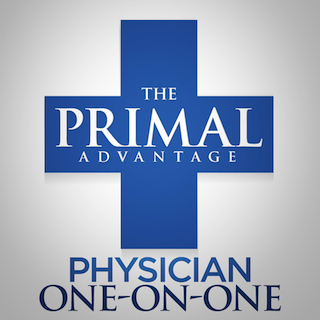 It’s a big day here at Mark’s Daily Apple! Today I am pleased to introduce The Primal Advantage metabolic consulting program. Finally, you can engage one-on-one with a respected medical expert aligned with Primal principles to fine tune your metabolic function. The Primal Advantage is overseen by Dr. Cate Shanahan, a family practice physician from Napa, CA, one of the leading MD’s in the ancestral health community, popular PrimalCon presenter, and author (with her husband Luke) of two extremely popular books, Deep Nutrition and Food Rules.
It’s a big day here at Mark’s Daily Apple! Today I am pleased to introduce The Primal Advantage metabolic consulting program. Finally, you can engage one-on-one with a respected medical expert aligned with Primal principles to fine tune your metabolic function. The Primal Advantage is overseen by Dr. Cate Shanahan, a family practice physician from Napa, CA, one of the leading MD’s in the ancestral health community, popular PrimalCon presenter, and author (with her husband Luke) of two extremely popular books, Deep Nutrition and Food Rules.
I’ve realized a pressing need for Primal Blueprint to offer such 1:1 professional consulting for many years, due to the high volume of email questions I receive on matters of health and even medical conditions at Mark’s Daily Apple. Don’t get me wrong – I love fielding reader questions in my weekly Dear Mark column. However, a significant percentage of my reader questions relate to medical matters that are not appropriate for me to answer. Turning to a “regular” doctor for support when you are committed to Primal living but struggling with certain health issues, confused about risk factors, or second-guessing your prescription drug regimen, can often be highly problematic. Particularly when it comes to the link between nutrition and health, your doctor is unlikely to be qualified to offer sensible guidance.
While I have great respect for all the leading voices in the primal/paleo/ancestral health movement, I have incredible appreciation for the medical doctors who have embraced the movement and spoken up to oppose the status quo mindset in their profession – folks like Dr. Cate, Dr. Ronesh Sinha, author of The South Asian Health Solution, and many others (Dr. Doug McGuff, Dr. Michelle Blackwell, Dr. Lauren Jefferis among them).
 While I enjoyed Cate’s book Deep Nutrition upon it’s release in 2010, she really caught my attention when she hooked up with my beloved Los Angeles Lakers to advise them on road trip meal planning and individual player diets in 2012. As Cate will tell you, it ain’t easy to the get the attention of a superstar like Kobe Bryant, let alone inspire trust and confidence in a radically different way of eating (check some of the links at the bottom of the Primal Advantage page; even the amazing physical specimens in the NBA are more inclined to chow down junk food than sensible dietary practices. Cate even diagnosed Dwight Howard with dysesthesia – his excess sugar consumption was compromising his fine motor skills and causing him to drop passes!).
While I enjoyed Cate’s book Deep Nutrition upon it’s release in 2010, she really caught my attention when she hooked up with my beloved Los Angeles Lakers to advise them on road trip meal planning and individual player diets in 2012. As Cate will tell you, it ain’t easy to the get the attention of a superstar like Kobe Bryant, let alone inspire trust and confidence in a radically different way of eating (check some of the links at the bottom of the Primal Advantage page; even the amazing physical specimens in the NBA are more inclined to chow down junk food than sensible dietary practices. Cate even diagnosed Dwight Howard with dysesthesia – his excess sugar consumption was compromising his fine motor skills and causing him to drop passes!).
Essentially, Cate is blending the best of medical science with ancestral health principles, and her experience in metabolic consulting with everyone from regular patients in her clinic to the world’s greatest professional athletes. When you participate in The Primal Advantage, you work 1:1 with Cate to fine-tune your dietary habits for weight loss, peak performance, and minimizing disease risk. Everything happens online or over the telephone, so this program is accessible to you wherever you live in the world.
Watch Mark Sisson and Dr. Cate Shanahan Discuss The Primal Advantage
While this program carries a decent price tag, it’s a pretty intensive relationship involving blood work (it’s a cinch to order Cate’s designated test package and get drawn locally with DirectLabs.com) that gets sent directly to Dr. Cate, complete a detailed health questionnaire online, and prepare an online food diary – all of which Cate will evaluate in detail with you over the phone as she prepares your Metabolic Snapshot™. The Metabolic Snapshot assesses your current health in six different categories: Cardiovascular, Intestinal, Energy, Immune system, Brain/Nervous system, and Connective Tissue. During your consultation, she will provide detailed dietary guidelines that enable you to improve your metabolic health scores and experience peak performance.
When you consider that the average family physician like Cate is mandated to spend only around seven minutes with each patient per traditional health care business model, this program is a bargain for the amount of personal consultation time you receive. Furthermore, working with Cate to improve your Metabolic Snapshot could help you discover blind spots in your dietary approach even if you are a devoted primal enthusiast. Check out Dr. Cate’s 2013 post where she discussed her consultation with Primal Blueprint’s own Brad Kearns. Brad was by all accounts a super healthy guy and exceptional athlete, but he too had dietary shortcomings identified by Dr. Cate that was compromising his performance and recovery.
Listen to The Primal Blueprint Podcast Episode #26: Introducing Dr. Cate Shanahan and The Primal Advantage
So, if you are dealing with nagging health or metabolic issues, wishing to bust out of a body composition plateau, have been frustrated by mainstream medical care that either conflicts with or is uninformed about your primal practices, or have no complaints but might enjoy a breakthrough in athletic performance, consider participating in The Primal Advantage. The Primal Advantage page explains the program components in more detail. Upon your registration, you will be given step-by-step instructions for completing the necessary blood, diet, and questionnaire elements and how to schedule your telephone appointment with Dr. Cate. Also note that after completing the initial program package, you can engage with Dr. Cate at any time in the future for follow-up 30- or 60-minute telephone consults.
Note: Since this post marks the official launch of The Primal Advantage program, I encourage you to act quickly and lock in your consulting time with Dr. Cate before she gets too busy. In anticipation of an enthusiastic response to the program, Dr. Cate is currently preparing a team of like-minded physicians to become Primal Advantage consultants, but currently the program capacity is limited by Dr. Cate’s availability. If you have any questions about The Primal Advantage, please feel free to visit the Primal Advantage page and live chat (lower right pop-up tab), email or call 888-774-6259 to discuss further.
Learn More About The Primal Advantage and Lock in Your Spot Here>>




July 1, 2014
Why Kids Need the Sun
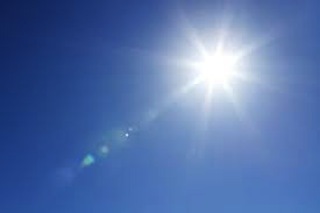 This is a guest post from Michelle Fitzpatrick of Happy Paleo Kids. Michelle has worked with special needs children and their families for over 13 years to promote development and mental health. She adopted a “Paleo Diet” to lose weight after baby number 3, and quickly saw that the benefits of eating nutrient-rich, plant-and-animal-based foods would benefit her entire family. After applying the Paleo Philosophy to her family, she felt compelled to find a way to bring the science behind how food impacts child development to the masses. Follow her blog or keep up to date on Facebook, Twitter, and Instagram.
This is a guest post from Michelle Fitzpatrick of Happy Paleo Kids. Michelle has worked with special needs children and their families for over 13 years to promote development and mental health. She adopted a “Paleo Diet” to lose weight after baby number 3, and quickly saw that the benefits of eating nutrient-rich, plant-and-animal-based foods would benefit her entire family. After applying the Paleo Philosophy to her family, she felt compelled to find a way to bring the science behind how food impacts child development to the masses. Follow her blog or keep up to date on Facebook, Twitter, and Instagram.
Yes! It’s summer! School is out, the sun is shining, and the kids are… glued to the iPad? I hope not. Summer is time for busy kids to catch up on things they don’t have time for during the school year (like play). Most importantly, it is a time when days are long and the sun shines bright.
Our bodies are dependent on the sun to function properly. Paleolithic children basked in the sun’s rays, which regulate vitamin D production, brain chemistry, and circadian rhythms (sleep cycles). Today’s kids spend little time outdoors in comparison. Meals and leisure activities often take place inside, with the average 8-18-year-old spending about 7 hours per day in front of a screen (eek!).
Sun is a commodity that is free (tell that to your friends that say the paleo lifestyle is expensive!), ample in summer (I know, this depends on where you live), and provides a wealth of health benefits. This summer is a great time for your family to create a habit of getting as much sun time as possible. A habit to carry out through the school year and beyond.
Vitamin D Production
 About 90% of the body’s vitamin D is produced by the body when sunlight hits the skin. Vitamin D plays a crucial role throughout the body. It helps metabolize and absorb calcium and other minerals (including zinc, magnesium, iron, and phosphate). It influences proteins that trigger gene expression (that is, turn genes on and off) and has a profound impact on the production of feel-good brain chemicals, such as beta-endorphins and serotonin. It modulates cell growth, neuromuscular function, immune function, and helps reduce inflammation.
About 90% of the body’s vitamin D is produced by the body when sunlight hits the skin. Vitamin D plays a crucial role throughout the body. It helps metabolize and absorb calcium and other minerals (including zinc, magnesium, iron, and phosphate). It influences proteins that trigger gene expression (that is, turn genes on and off) and has a profound impact on the production of feel-good brain chemicals, such as beta-endorphins and serotonin. It modulates cell growth, neuromuscular function, immune function, and helps reduce inflammation.
Vitamin D is an important compound for kids’ developing bodies. Significant vitamin D deficiency prenatally through the first few months of life can lead to rickets, a disease that is characterized by soft, weak bones and poor motor development. In rats, developmental vitamin D deprivation leads to altered brain structure and function (with altered brain cell growth and “differentiation”) [1], impaired attention and impulsivity. [2] [3]
Scientists have not yet examined vitamin D and cognitive performance in healthy developing children. However, there is undisputed evidence that low vitamin D levels are associated with decreased cognitive functioning in adults and increased risk for dementia and Alzheimers in the elderly. [4] The pattern correlating cognitive deficiencies with low vitamin D likely continues down into childhood (now if only the research would catch up).
Children with ADHD [5], autism [6], and depression have been found to have lower blood levels of vitamin D than their typically developing peers. Researchers don’t yet understand the nature of the relationship between vitamin D and ADHD or autism – are low serum levels of D triggering the expression of genes for these behaviors? Is there a disruption to the biosynthetic process of converting UVB rays into the vitamin D in these children? Time will tell. Intervention studies have not yet been conducted, but it’s possible that exposure to sunlight decreases behaviors associated with those disorders by increasing blood levels of vitamin D serum.
Circadian Rhythm Regulation
 Sunlight is necessary to regulate our circadian rhythms (that is, our “internal clock” which determines our sleep/wake cycle). During evolutionary times, being active and awake during nighttime meant an increased chance of being eaten by a mountain lion or falling off a cliff. It was in our best interest to sleep during hours of darkness in order to decrease such risk. Modern amenities have lead to a decreased risk of harm at night, but they have also led to serious disruption of our circadian rhythms.
Sunlight is necessary to regulate our circadian rhythms (that is, our “internal clock” which determines our sleep/wake cycle). During evolutionary times, being active and awake during nighttime meant an increased chance of being eaten by a mountain lion or falling off a cliff. It was in our best interest to sleep during hours of darkness in order to decrease such risk. Modern amenities have lead to a decreased risk of harm at night, but they have also led to serious disruption of our circadian rhythms.
The American Association of Pediatrics recommends that children sleep about 9-13 hours per night (depending on age). Sleep is a time when hormones and macronutrients go to work in the body so that bones, muscles, and organs can grow. The brain consolidates memories, processes emotions, produces important neurotransmitters in preparation of the day to come, and oxidative stress due to environmental toxins are detoxified.
But a 2004 national survey found that the average kid’s Z’s are falling short.
A 2013 study found that children who increase their daily sleep by one hour had improved emotion regulation, decreased impulsivity, and improved attention and behavior. [7] Restricted sleep has the opposite effect: decreased attention, memory (short and long term), academic performance, as well as difficulty with decision making, behavioral outbursts, depression and anxiety. [8] [9]
Serotonin Production
Exposure to sunlight influences the production of serotonin, a chemical messenger in the brain (neurotransmitter) used to regulate mood and emotion (this is in part due to increased vitamin D and in part due to well balanced circadian rhythms). Researchers believe that serotonin plays an important role in brain development, as children actually have higher levels of serotonin than adults. Increased levels of serotonin is related to feelings of well-being, joy and happiness in children, whereas low levels of serotonin are related to impulsivity, aggression, depression, anxiety and other developmental problems. [10]
More Time Outdoors
 When kids are outdoors they are less likely to be sedentary. Outside there are infinite ways to get moving, including walking, playing basketball, or climbing at the playground. And if your kids aren’t being active they are still interacting with their environment in ways that are more beneficial to their development than if they are in front of a screen. Playing in the sandbox is great for sensory integration, and playing in the dirt can help improve their immune system. Simply going outside to read or eat a snack can be advantageous. Researchers have found that just hearing sounds and seeing sites of nature can have a positive, calming effect. [11]
When kids are outdoors they are less likely to be sedentary. Outside there are infinite ways to get moving, including walking, playing basketball, or climbing at the playground. And if your kids aren’t being active they are still interacting with their environment in ways that are more beneficial to their development than if they are in front of a screen. Playing in the sandbox is great for sensory integration, and playing in the dirt can help improve their immune system. Simply going outside to read or eat a snack can be advantageous. Researchers have found that just hearing sounds and seeing sites of nature can have a positive, calming effect. [11]
Now put down the device on which you are reading this (after you go over and bookmark Happy Paleo Kids, of course  ) and take your kids to the park (or schedule an evening walk with friends or SOMETHING). Go!
) and take your kids to the park (or schedule an evening walk with friends or SOMETHING). Go!
References
Not a Subscriber? You Are Missing Out. Subscribe for Free Today and Instantly Get 8 Primal eBooks and So Much More!




June 30, 2014
Dear Mark: Red Meat and Breast Cancer, Net Carbs, and Solutions for Excess, Unavoidable Sun
 For today’s Dear Mark, we’ve got a three-parter. First up, I discuss the latest study claiming that red meat will kill us all. Or maybe it’ll be killing roughly half of us all, seeing as how this paper concerns red meat and women’s breast cancer risk. Next, I give my position on the “net carbs” issue. Do we subtract fiber, leave it as is, or do something else entirely? And finally, I talk a lot about the importance of getting enough sunlight. But what happens when getting enough sun isn’t the problem? What can an outdoor worker do about too much sun?
For today’s Dear Mark, we’ve got a three-parter. First up, I discuss the latest study claiming that red meat will kill us all. Or maybe it’ll be killing roughly half of us all, seeing as how this paper concerns red meat and women’s breast cancer risk. Next, I give my position on the “net carbs” issue. Do we subtract fiber, leave it as is, or do something else entirely? And finally, I talk a lot about the importance of getting enough sunlight. But what happens when getting enough sun isn’t the problem? What can an outdoor worker do about too much sun?
Let’s go:
Hi Mark,
I would love to hear your take on the new study claiming that red meat raises women’s breast cancer risk. This has been all over the news without any dissuasion of other variables such as: it was a “recall” study where subjects were asked what they ate over the past 20 years, was there a category distinguishing McDonald’s cheeseburgers vs. grass fed filet, were the participants who remembered eating less red meat consistently active, how did the subjects obesity levels factor into the results, etc. It seems that this is a big leap to take in a study based on memory of what nurses ate. Thanks!
K. Hunter
Oh look, Walter Willett has authored another study condemning red meat. I’ll always respect and admire his voluminous mustache, but I don’t think much of this latest paper. You point out a lot of shortcomings in your question. Yes, it was a recall study. No, they didn’t distinguish between fast food burgers and pastured steak. They didn’t control for activity levels (which definitely affect the risk of getting breast cancer), though they did for obesity. The biggest thing that jumps out is that they didn’t separate unprocessed red meat from processed red meat. From the Methods section:
Total red meat items listed on the food frequency questionnaire included unprocessed red meat (beef, pork, or lamb as a sandwich, pork as a main dish, beef or lamb as a main dish, and hamburger) and processed red meat (hot dogs, bacon, and other processed meat such as sausage, salami, bologna).
That’s pretty unforgivable, and if you stopped reading now to go eat a beef shank, I wouldn’t blame you. Confounding processed and unprocessed red meat means that a nurse who brought in leftover osso buco would be lumped in with the nurse who ate microwaved Oscar Mayer hot dogs for lunch everyday. Does anyone really think that hot dogs and braised veal have the same effect on breast cancer risk? Or even a similar effect? “Red meat” is not a monolith. It’s just a term we use to categorize foods that share a few characteristics. This makes discussing foods easier, but our discussions become less precise and any conclusions gleaned from them less meaningful. I don’t blame them, really. Breaking up “red meat” into grain-fed beef, grass-fed and grain-finished beef, grass-fed/finished beef, pastured pork, conventional pork, and so on would produce the most accurate results, but it would make research difficult to conduct.
Such categories may make research easier, but you’re not eating “red meat.” You’re eating from among the thousands of foods that qualify as red meat. And since this study didn’t even distinguish between the most basic sub-categories (processed red meat and unprocessed red meat), it’d be unwise to ascribe it any significance, let alone modify our diet based on its conclusions.
It’s not like this is a novel pursuit, a foray to an untapped reservoir of nutritional epidemiology. It’s old news. People have been looking for evidence that red meat increases the risk of breast cancer for years. By and large, they’ve come up empty. Even looking at the constituents of red meat for evidence of a link hasn’t gone anywhere. Heme iron, the type found abundantly in red meat, is not associated with breast cancer risk. Fried meat is sometimes associated with breast cancer, but other studies have found that a person’s intake of heterocyclic amines, the carcinogens that form when meat is cooked and seared under high heat, has no association (but omega-6 intake seems to be connected). Oh, and how about animal fat? No relationship with breast cancer risk.
Even if this paper was sound and relevant to a healthy Primal eater, we know that many nutrients found in red meat, like conjugated linoleic acid (CLA), are associated with a reduced risk of breast cancer. Another one, carnitine, appears to be protective once a person has breast cancer. I’m not saying that eating steak will cure or prevent breast cancer. That’s not really supported by the evidence, though a few potential mechanisms (CLA, carnitine) look promising. I’m saying that the opposite statement – that red meat increases the risk of breast cancer – has even less support in the literature. It’s the same crazy situation where even though gouda is one of the best sources of vitamin K2, a heart-protective nutrient widely recognized by health experts, they tell heart disease patients to get their vitamin K2 from supplements, not gouda, because “full-fat cheese is bad for your heart.”
So yeah, this paper isn’t groundbreaking, and I don’t think it tells us anything about the effects of eating grass-fed lamb, but it’s still not a very good idea to eat a lot of fried, well-done, and/or processed meat. And make sure you exercise.
Hello
I picked up The Primal Blueprint about a year ago, and have been following it ever since. I am not overweight for the first time in my adult life, and feel incredible. I am still struggling to lose the last 10 or so pounds, and get my body fat into a healthier range. I am diligently staying within the 50-100g/day carb range, with a few days here and there of below 50, and seem to be stuck on this plateau. My question is, are you recommending to stay within 50-100g of total carbs, or factor in the fiber and go by net carbs? I have been going by total carbs, which means I’m netting around 40-60 carbs a day (around 60-90 total carbs). I’m not sure if this is my sweet spot, since I can’t seem to get this last bit of weight off, and would love your opinion!
Betsy
I don’t really do the “net carb” thing. That often leads to micromanagement, which is bad for some people. If you love to micromanage and thrive doing it, have at it.
I find it easier (and more helpful) to think of non-starchy vegetables as “free” than to subtract fiber from total carbohydrate, and it accomplishes similar things. Leafy greens? Broccoli? Bok choy? Summer squash? Zucchini? Cabbage? Eat as much as you want. The carbohydrates are negligible (you probably use more glucose digesting non-starchy vegetables than they contain) and they’re inherently self-limiting. No one is carbing up with a salad bowl full of a couple pounds of steamed kale before a race; it simply wouldn’t work. No one is carb-binging on spinach the way they might binge on roasted potatoes; spinach technically has carbs, but not really. No one is getting fat because they ate too much lettuce unless it’s drowning in dressing; you’d get sick of it before you could consume a significant enough amount of lettuce calories.
The carbs on the Primal Blueprint Carb Curve primarily refer to carbohydrates from starchy vegetables (winter squash, beets, etc), tubers, roots, and fruit.
What’s up, Mark? I just started a new job at a marina. It’s great – I’m outdoors for much of the day, I’m active and moving, and I’m doing something that I love which is working on boats.
Here’s my question: Since I am outdoors much of the day, I’m concerned about getting too much sun. I love getting some sunshine and I know the sun isn’t poisonous, but sometimes I’m out in it for 6 to 7 hours at a time (minus a few breaks here and there).
You usually recommend people head inside or get out of the sun when they feel like they’ve had enough, but that’s not always an option when I’m working. Since summer’s here now, and people are going to be on the lake or at the beach, I’m curious what you would recommend when getting out of the sun isn’t necessarily an option.
Should I use sunscreen? Another alternative? The main goal is just to keep from burning, right?
Thanks!
John
First off, the fact that you’re moving around all day helps. Rather than laying out and exposing a big uniform slab of flesh to direct sunlight for an extended, unbroken amount of time, your work on the boats has you bending, pulling, crawling, and contorting yourself and exposing different bits of skin to the sun. This is safer than direct protracted exposure. It’s known as “occupational sun exposure,” and it’s usually linked to less skin cancer than intermittent sun exposure.
Second, not burning is a good sign. It’s certainly better than burning, which definitely increases the risk of melanoma. And people with the innate (or cultivated through dietary and other lifestyle measures) ability to tan rather than burn are less likely to develop deadly skin cancer. Despite the conventional wisdom, a light base tan is not a definite indicator of irreparable skin damage. Assuming you go about attaining it the right way – through steady and measured, rather than intermittent sun exposure – it indicates good sun resistance.
However, six or seven hours is still a long time to be out in the sun and sunscreens may be a good bet. Some sunscreens work better (and are less toxic) than others. Zinc oxide – the white, goopy stuff that doesn’t really disappear after application – actually provides a physical, rather than chemical, barrier that protects against both UVA and UVB; most chemical barriers block only UVB, thus preventing the synthesis of vitamin D that helps protect your skin from the UVA. Some of the latest zinc oxide sunscreens are better at blending in, but they’re not perfect. You’ll still give off a faint white sheen (which is better than a burn). Focus on the areas of your body that receive the most direct sun, like your shoulders, neck, nose bridge, and clavicles. The Badger Balm line of zinc oxide sunscreens provides a physical barrier and manages to be somewhat inconspicuous.
Cover up. Get a wide-brimmed hat if your job allows it. Bucket hats, or fishermen’s hats, are designed to ward off sun and do a good job at it. Clothing is good, too. UV-protective clothing, or “sunware,” is designed to protect you from the sun. If you want protective clothing but would rather not wear a skin-tight rash guard, go to a hiking/camping/backpacking store. They’ll have UV-protective clothes that look like normal shirts, shorts, and pants. For regular clothing, color matters, with blue and red having the best UV-blocking capacity.
Make sure your diet is replete with nutrients that bolster your sun resistance. I’ve outlined eight of the main ones in this post. The biggest change I’ve seen has come from limiting omega-6 fatty acid intake (particularly from seed or vegetable oils; nuts and eggs and other whole food sources of PUFAs are more desirable and less problematic than the oils), eating more saturated fat to make up for it, and getting sufficient omega-3 from fish, shellfish, or fish oil supplements.
That’s it for today, folks. Thanks for reading and be sure to leave a comment!
Not a Subscriber? You Are Missing Out. Subscribe for Free Today and Instantly Get 8 Primal eBooks and So Much More!




June 29, 2014
Weekend Link Love
 Episode #25 of The Primal Blueprint Podcast is now live. Host Brad Kearns and I talk to Dr. Ron Sinha (author of The South Asian Health Solution) about his battle to change the position of the mainstream medical community on dietary fat and cholesterol and help them realize the roles of stress, inactivity, and high insulin in heart disease. It’s certainly hard fought, but he’s working from the inside and has as good a shot as anyone. If you have any ideas for future podcasts, please let us know by using the blue “Submit a Question” button in the sidebar!
Episode #25 of The Primal Blueprint Podcast is now live. Host Brad Kearns and I talk to Dr. Ron Sinha (author of The South Asian Health Solution) about his battle to change the position of the mainstream medical community on dietary fat and cholesterol and help them realize the roles of stress, inactivity, and high insulin in heart disease. It’s certainly hard fought, but he’s working from the inside and has as good a shot as anyone. If you have any ideas for future podcasts, please let us know by using the blue “Submit a Question” button in the sidebar!
If you know someone who could use a lifestyle overhaul but hasn’t the time or inclination to read, the perfect solution is now available: the Audible audiobook version of the bestselling The Primal Blueprint 21-Day Total Body Transformation.
Research of the Week
Although we primarily tout it for its nutrient density, chicken liver also increases endogenous antioxidant capacities in those who eat it.
Fecal analysis confirms that Neanderthals ate a diet of mostly animals with some vegetation.
Some athletes may be eating so many carbohydrates that they inhibit the training effect.
Interesting Blog Posts
If you were to ask the human body, folic acid really isn’t the same as folate.
A fairly complete guide to storing produce of almost every kind.
Are we aging faster than we should? According to Dr. Ron, the answer is a resounding “yes.”
Media, Schmedia
Consumers are more interested in no- and low-sugar products than no- and low-fat products. A good sign.
Patients with multiple sclerosis are increasingly turning to “paleo-type” diets to manage their condition.
I recently gave my take on the healthiest, easiest way to lose weight and feel great.
Everything Else
The American continents once hosted an incredible number of indigenous tribes.
This video blew my mind and changed how I look at butter forever.
Tabless Thursdays sounds way better than Meatless Mondays.
How to make doctors irrelevant (it involves a Primal way of eating).
Recipe Corner
Pizza for breakfast? Yes, and it’s grain-free.
Fish out that neglected jar of shrimp paste you bought on a whim from the fridge and make this incredible dish: sambal terung, Malaysian roasted eggplant with chili sauce.
Time Capsule
One year ago (June 29 – July 5)
5 Things I Still Struggle With – I’m far from perfect. Here’s what I’m still working on.
Why You Should Let Yourself Succeed and Go Get the Life You Want – It’s obvious why you should do that (it will make you happy and fulfilled), but here’s why it’s so important.
Comment of the Week
I get dirty every day in the garden, but I stopped having dirt smoothies b/c I found out that soil has giardias in it sometimes. I don’t know how common this is, but giardias are not just in lakes and streams.
- In case it wasn’t clear, I was kidding about the soil smoothies. Though I suspect it could be therapeutic or helpful in some cases to consciously eat dirt, it’s too risky for precisely this reason.
Like This Blog Post? Dig Deeper with Primal Blueprint Books and Learn How You Can Reprogram Your Genes to Become Leaner, Stronger and Healthier




Mark Sisson's Blog
- Mark Sisson's profile
- 199 followers



